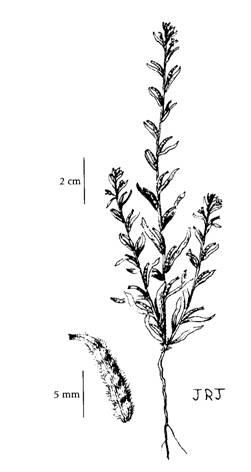Brook spike-primrose (Epilobium torreyi) COSEWIC assessment and status report: chapter 3
Species Information
Name and classification
Oenothera densiflora Lindl. var. tenella Gray
Oenothera torreyi Wats.
There are no infraspecific taxa recognized in Epilobium torreyi. Many older floras place it in the genus Boisduvalia (B. stricta) which differs from Epilobium by lacking a tuft of silky hairs (coma) at the summit of each seed. Hoch and Raven (1992) did not feel this distinction warranted separation at the genus level so in their definitive treatment they included the species within the genus Epilobium.
Morphological description
Epilobium torreyi is an annual herb from a taproot (Figure 1). Stems are ascending to erect, 10-60 cm tall. Larger plants are branched from the base with the outer tissue of the lower stem peeling, but most Canadian plants are unbranched and too small to peel. Plants are greyish with spreading hairs, and leaves are opposite only near the base. Leaves are linear or narrowly lanceolate, reduced above, entire or remotely fine-toothed, hairy but nearly glabrous near the base and nearly stalkless. The flowering inflorescence is loose to somewhat crowded in a leafy, terminal spike, and glandular; inflorescence leaves are similar to others but entire and smaller. Flowers are fertilized in the bud and do not open. Petals are 1-3 mm long, pink or white and the sepals are 0.7-2 mm long. Stigmas are generally subcapitate, rarely 4-lobed. Capsules are cylindric, about 8-13 mm long, flexible, curved near the tip, long-hairy, short-beaked and 4-chambered. The valve adheres to the partitions and the axis breaks up as the seeds are shed. Each chamber of the capsule holds 6-8 seeds, 1-1.5 mm long. Seeds are smooth and without a tuft of hairs (Douglas and Meidinger 1999).
Figure 1. Illustration of Epilobium torreyi. Illustrated by Jeanne R. Janish with permission from University of Washington Press.

Epilobium torreyi may be mistaken for E. densiflorum, also a rare species in British Columbia. The two species may occur together. Table 1 summarizes significant differences between the two species.
| Character | Epilobium densiflorum | Epilobium torreyi |
|---|---|---|
| Petal length | (2.5) 3–8 (12) mm | 1-3 mm |
| Capsules | slenderly fusiform, beakless | narrower with prominent, curved beak |
| Internal septa | completely free from valves | adherent to valves |
| Flowers | crowded (inflorescence elongating in fruit) | usually not crowded |
| Leaf shape | lanceolate to ovate | linear to narrowly lanceolate |
Genetic description
Epilobium torreyi has a gametic chromosome number of n=9. Closely related species have a gametic chromosome number of 10, and E. torreyi has apparently evolved, through aneuploidy, from ancestors with n=10. Such aneuploidy changes in chromosome numbers in the Onagraceae appear to have been correlated with adaptation to increasingly xeric conditions (Raven 1979).